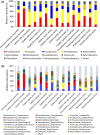Gut microbiome of migratory shorebirds: Current status and future perspectives
- PMID: 33976772
- PMCID: PMC8093701
- DOI: 10.1002/ece3.7390
Gut microbiome of migratory shorebirds: Current status and future perspectives
Abstract
Migratory shorebirds have many unique life history characteristics, such as long-distance travel between breeding sites, stopover sites, and wintering sites. The physiological challenges for migrant energy requirement and immunity may affect their gut microbiome community. Here, we reviewed the specific features (e.g., relatively high proportion of Corynebacterium and Fusobacterium) in the gut microbiome of 18 migratory shorebirds, and the factors (e.g., diet, migration, environment, and phylogeny) affecting the gut microbiome. We discussed possible future studies of the gut microbiome in migratory shorebirds, including the composition and function of the spatial-temporal gut microbiome, and the potential contributions made by the gut microbiome to energy requirement during migration.
Keywords: composition and function; energy requirement; migratory shorebirds; the gut microbiome.
© 2021 The Authors. Ecology and Evolution published by John Wiley & Sons Ltd.
Conflict of interest statement
The authors declared no conflicts of interest relevant to this manuscript.
Figures





Similar articles
-
Active migration is associated with specific and consistent changes to gut microbiota in Calidris shorebirds.J Anim Ecol. 2018 Mar;87(2):428-437. doi: 10.1111/1365-2656.12784. Epub 2017 Dec 18. J Anim Ecol. 2018. PMID: 29111601
-
Stopover habitat selection drives variation in the gut microbiome composition and pathogen acquisition by migrating shorebirds.FEMS Microbiol Ecol. 2024 Apr 10;100(5):fiae040. doi: 10.1093/femsec/fiae040. FEMS Microbiol Ecol. 2024. PMID: 38515294 Free PMC article.
-
Composition and Drivers of Gut Microbial Communities in Arctic-Breeding Shorebirds.Front Microbiol. 2019 Oct 9;10:2258. doi: 10.3389/fmicb.2019.02258. eCollection 2019. Front Microbiol. 2019. PMID: 31649627 Free PMC article.
-
Understanding the ecological and evolutionary function of stopover in migrating birds.Biol Rev Camb Philos Soc. 2022 Aug;97(4):1231-1252. doi: 10.1111/brv.12839. Epub 2022 Feb 8. Biol Rev Camb Philos Soc. 2022. PMID: 35137518 Review.
-
Host Genetics and Gut Microbiome: Challenges and Perspectives.Trends Immunol. 2017 Sep;38(9):633-647. doi: 10.1016/j.it.2017.06.003. Epub 2017 Jun 29. Trends Immunol. 2017. PMID: 28669638 Review.
Cited by
-
Comparison of the Intestinal Bacterial Communities between Captive and Semi-Free-Range Red-Crowned Cranes (Grus japonensis) before Reintroduction in Zhalong National Nature Reserve, China.Animals (Basel). 2023 Dec 19;14(1):3. doi: 10.3390/ani14010003. Animals (Basel). 2023. PMID: 38200734 Free PMC article.
-
Gut microbiota enhance energy accumulation of black-necked crane to cope with impending migration.Appl Microbiol Biotechnol. 2023 Jul;107(14):4635-4646. doi: 10.1007/s00253-023-12598-x. Epub 2023 May 30. Appl Microbiol Biotechnol. 2023. PMID: 37249588
-
Ecosystem Microbiome Science.mLife. 2023 Jan 11;2(1):2-10. doi: 10.1002/mlf2.12054. eCollection 2023 Mar. mLife. 2023. PMID: 38818334 Free PMC article.
-
The diet-intestinal microbiota dynamics and adaptation in an elevational migration bird, the Himalayan bluetail (Tarsiger rufilatus).Ecol Evol. 2024 Jun 29;14(7):e11617. doi: 10.1002/ece3.11617. eCollection 2024 Jul. Ecol Evol. 2024. PMID: 38952660 Free PMC article.
-
Seasonal variation in gut microbiota of migratory wild raptors: a case study in white-tailed eagles.Anim Microbiome. 2025 Apr 17;7(1):37. doi: 10.1186/s42523-025-00406-y. Anim Microbiome. 2025. PMID: 40247417 Free PMC article.
References
-
- Alerstam, T. , Hedenström, A. , & Åkesson, S. (2003). Long‐distance migration: Evolution and determinants. Oikos, 103, 247–260. 10.1034/j.1600-0706.2003.12559.x - DOI
-
- Archie, E. A. , & Tung, J. (2015). Social behavior and the microbiome. Current Opinion in Behavioral Sciences, 6, 28–34. 10.1016/j.cobeha.2015.07.008 - DOI
Publication types
LinkOut - more resources
Full Text Sources
Other Literature Sources

